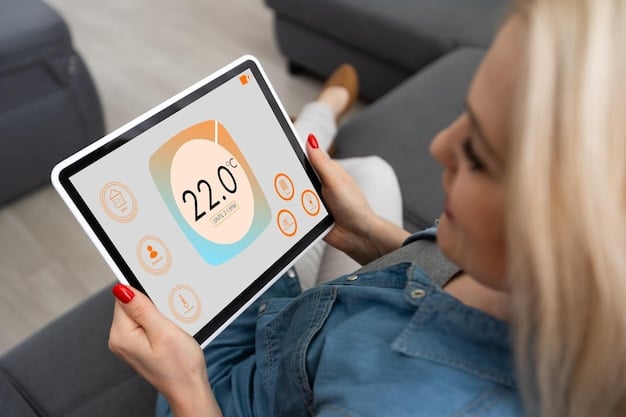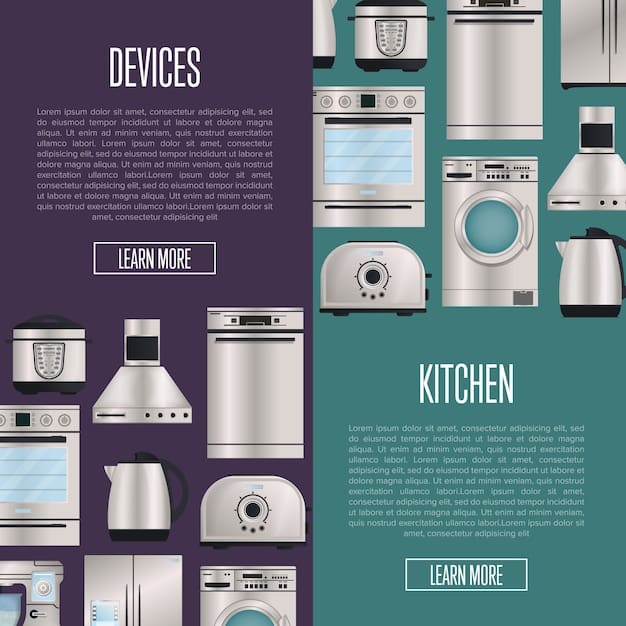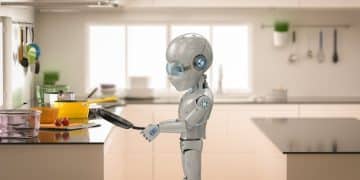Smart Homes: How Tech Will Cut Your Energy Bills by 15% in 2025

Smart home technology is poised to revolutionize energy consumption, with projections estimating a 15% reduction in energy bills by 2025 through automated adjustments, optimized usage, and real-time monitoring enabled by interconnected devices.
Are you dreaming of lower energy bills? How Will Smart Home Tech Reduce Energy Bills by 15% in 2025? It’s not just a futuristic fantasy; it’s a rapidly approaching reality thanks to smart home innovations.
The Rise of the Energy-Efficient Smart Home
The concept of a smart home, once relegated to science fiction, has rapidly become a tangible reality for millions of homeowners. Fueled by advancements in technology and an increasing awareness of environmental sustainability, smart homes are transforming our living spaces into interconnected ecosystems that seamlessly blend convenience with efficiency.
As we look towards 2025, the potential for smart home technology to revolutionize energy consumption is becoming increasingly apparent. While the promise of reduced energy bills is appealing, understanding the driving forces behind this shift is crucial.
What Defines an Energy-Efficient Smart Home?
An energy-efficient smart home goes beyond simply installing a few gadgets. It’s about creating a holistic system where devices communicate with each other, optimizing energy usage based on real-time data and user preferences.
- Smart Thermostats: Learning your schedule and adjusting temperatures automatically to avoid wasting energy.
- Smart Lighting: Using motion sensors, timers, and dimming capabilities to ensure lights are only on when and where they are needed.
- Smart Plugs: Monitoring and controlling the energy consumption of individual appliances, allowing you to identify and eliminate vampire energy drains.
- Energy Monitoring Systems: Providing real-time data on your energy usage, empowering you to make informed decisions about how to conserve energy.
The integration of these technologies allows homeowners to gain unprecedented control over their energy consumption, leading to significant savings and a reduced environmental footprint.
In conclusion, the energy-efficient smart home represents a significant leap forward in how we interact with our living spaces. By embracing these technologies, homeowners can look forward to a future where convenience and sustainability go hand-in-hand.
Smart Thermostats: The Core of Energy Savings
Smart thermostats have emerged as a cornerstone of energy-efficient smart homes. Unlike traditional thermostats that simply maintain a set temperature, smart thermostats leverage advanced algorithms and connectivity to optimize heating and cooling based on your specific needs and habits.
By learning your schedule, adapting to weather conditions, and allowing remote control, smart thermostats offer a powerful means of reducing energy waste and lowering your utility bills.
How Smart Thermostats Learn and Adapt
The key to a smart thermostat’s energy-saving capabilities lies in its ability to learn and adapt to your lifestyle. Over time, the thermostat monitors your temperature preferences, detects patterns in your daily routine, and adjusts its settings accordingly.
- Learning Your Schedule: Automatically adjusting temperatures based on when you are home or away.
- Weather Awareness: Accessing real-time weather data to anticipate temperature fluctuations and optimize heating/cooling.
- Remote Control: Allowing you to adjust temperatures from your smartphone or other devices, even when you are not home.

These features combine to create a personalized and highly efficient heating and cooling system that can significantly reduce energy consumption without sacrificing comfort.
In conclusion, smart thermostats are not just a convenient upgrade to your home; they are a powerful tool for saving energy and reducing your environmental impact. By embracing this technology, homeowners can take control of their heating and cooling costs and contribute to a more sustainable future.
Smart Lighting: Illuminating Efficiency
Smart lighting systems offer a significant opportunity to reduce energy consumption in homes. These systems go beyond simple on/off switches, offering automated controls, dimming capabilities, and even color adjustments. By optimizing lighting usage based on time of day, occupancy, and natural light availability, smart lighting can contribute substantially to energy savings.
As we move towards 2025, integration of smart lighting will become increasingly seamless and intuitive, further boosting energy efficiency.
Key Features of Energy-Saving Smart Lighting
Smart lighting solutions encompass a range of features designed to minimize energy waste and maximize efficiency. These features work together to ensure that lights are only used when and where they are needed, and at the appropriate intensity.
Here are some key components:
- Motion Sensors: Lights turn on automatically when someone enters a room and turn off when the room is vacant.
- Timers and Schedules: Lights can be programmed to turn on and off at specific times, mimicking occupancy even when the home is empty.
- Dimming Capabilities: Adjusting brightness levels to reduce energy consumption while maintaining adequate illumination.
By incorporating these intelligent features, smart lighting systems optimize energy usage and provide convenience and security.
In summary, smart lighting represents a key step towards creating energy-efficient homes. By leveraging automation, customization, and intelligent sensors, these systems minimize energy waste and contribute to a more sustainable lifestyle.
Smart Appliances: Plugging the Energy Leaks
Household appliances are often overlooked contributors to high energy bills. From refrigerators to washing machines, these devices consume a significant amount of electricity, even when they are not actively in use. Smart appliances offer a solution to this problem by providing enhanced control, monitoring capabilities, and energy-saving features.
As we move closer to 2025, smart appliances are becoming increasingly sophisticated, allowing homeowners to identify and eliminate energy leaks that would otherwise go unnoticed.

How Smart Appliances Reduce Energy Consumption
Smart appliances use a variety of techniques to minimize energy waste and optimize performance. By connecting to the internet and communicating with other devices, they can adapt to changing conditions and user preferences.
Considerations include:
- Smart Refrigerators: Optimizing temperature settings based on usage patterns and providing alerts when doors are left open.
- Smart Washing Machines: Adjusting water levels and wash cycles based on the load size and type.
- Smart Ovens: Preheating only when necessary and automatically turning off after cooking is complete.
These smart features lead to substantial energy savings over time without compromising performance or convenience.
In conclusion, smart appliances are an essential component of any energy-efficient home. By monitoring energy usage, adapting to user behavior, and incorporating intelligent controls, these devices help homeowners reduce their carbon footprint and save money on their utility bills.
Integrated Energy Management Systems: The Big Picture
While smart thermostats, lighting, and appliances offer individual energy-saving benefits, the true potential of smart home technology is realized when these devices are integrated into a comprehensive energy management system. These systems provide a holistic view of energy consumption, allowing homeowners to identify areas for improvement and optimize their overall energy usage.
By connecting all of your smart devices and providing real-time data and control, these systems empower you to make informed decisions and take proactive steps to reduce your energy footprint.
Key Components of Integrated Energy Management Systems
Integrated energy management systems are not just a collection of smart devices; they are a carefully orchestrated network designed to optimize energy usage across your entire home. These systems typically include the following key components:
Below are some essential points:
- Centralized Control: A single interface for monitoring and controlling all of your smart devices.
- Real-Time Data: Instantaneous feedback on your energy consumption, allowing you to identify peak usage periods and potential problems.
- Automated Optimization: Adjusting device settings automatically based on weather conditions, occupancy patterns, and energy prices.
These features combine to create a highly efficient and user-friendly energy management system that can significantly reduce your energy bills and environmental impact.
In conclusion, integrated energy management systems represent the pinnacle of smart home technology. By providing a centralized view of your energy consumption and allowing for automated optimization, these systems empower you to take control of your energy usage and create a more sustainable home.
Predicting a 15% Reduction by 2025: Is It Realistic?
The projection that smart home technology will reduce energy bills by 15% by 2025 is ambitious, but achievable. Several factors contribute to this potential reduction, including technological advancements, increased adoption rates, and growing awareness of energy conservation.
By examining these factors, we can gain a better understanding of the feasibility of this projection and the potential impact of smart home technology on energy consumption.
Factors Supporting the 15% Reduction
Several key trends and developments support the projection that smart home technology will reduce energy bills by 15% by 2025.
These are outlined in the list below:
- Technological Advancements: Smart devices are becoming more efficient, more affordable, and easier to install.
- Increased Adoption: As more homeowners embrace smart home technology, the cumulative energy savings will become increasingly significant.
- Growing Awareness: Consumers are becoming more aware of the environmental and economic benefits of energy conservation, driving demand for smart home solutions.
These trends suggest that the adoption of smart home technology will continue to accelerate in the coming years, leading to significant reductions in energy consumption.
In summary, the projection that smart home technology will reduce energy bills by 15% by 2025 is grounded in solid evidence and supported by strong trends. As technology continues to advance and adoption rates continue to increase, the potential for smart homes to revolutionize energy consumption is becoming increasingly apparent.
| Key Point | Brief Description |
|---|---|
| 💡 Smart Thermostats | Adjust temperature based on schedule, saving energy automatically. |
| 🔆 Smart Lighting | Uses sensors and timers to ensure lights are on only when needed. |
| 🔌 Smart Appliances | Monitors energy usage of appliances, eliminating waste. |
| 📊 Energy Management | Integrated systems offer a holistic view of energy consumption. |
FAQ
Smart thermostats learn your habits and adjust temperatures automatically. They avoid heating or cooling empty homes by detecting when no one is around, drastically reducing energy waste.
Yes, smart lighting uses motion sensors and programmed schedules. This ensures lights are on only when needed, reducing your electricity usage and contributing to significant savings over time.
Smart refrigerators optimize temperature, while smart washing machines adjust water levels automatically. Smart ovens also shut off when cooking is done, minimizing energy waste from these main appliances.
The initial costs can vary, but many governments offer rebates for energy-efficient upgrades. Over time, energy savings offset the upfront expenses, potentially making this an affordable investment.
Most smart home systems provide detailed reports showing how much energy each device uses. Checking these reports helps you to understand savings and to fine-tune energy efficiency efforts.
Conclusion
As we approach 2025, the integration of smart home tech offers a clear path toward reducing energy bills. With smart thermostats, lighting, appliances, and integrated management systems working together, achieving a 15% cut in energy usage appears to be a very realistic prospect. The key lies in adopting these technologies and optimizing their use to suit individual needs and preferences.





